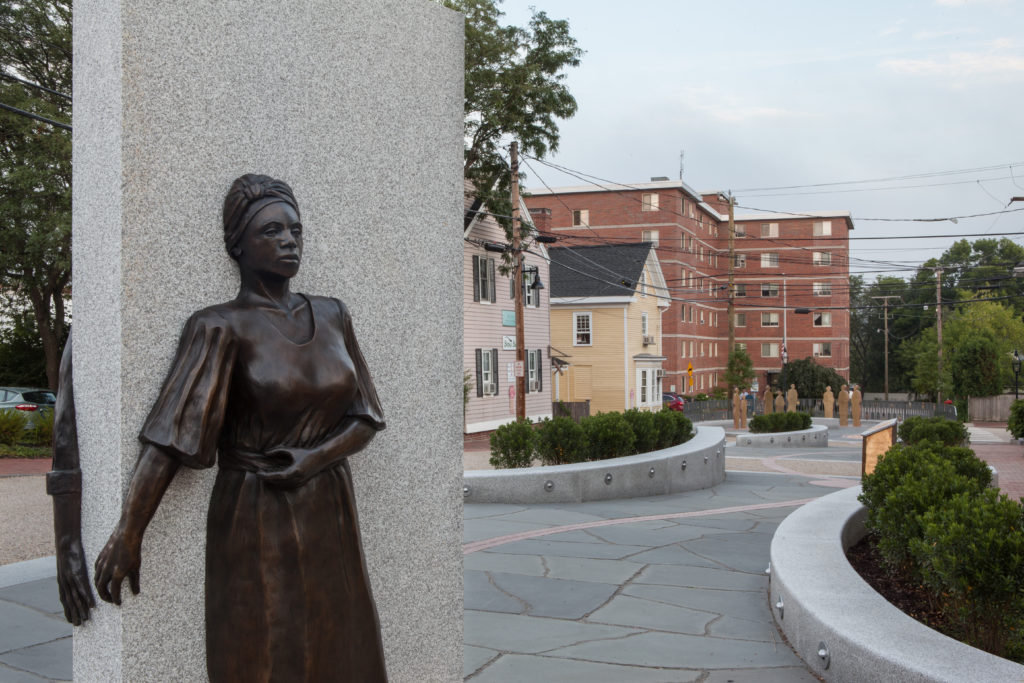Collect Day #11, THE PORTSMOUTH AFRICAN BURYING GROUND
Loving God, Author of our pasts, we thank you for the journeys of our ancestors, especially those who worked without recognition, without freedom, and with little hope. Whatever our condition today, we stand on their shoulders. Help us to remember this profound, simple truth. With gratitude, we affirm the dignity and worth of every child of yours. We name: their work, worthy; their lives, significant; their journeys, an essential link in our lives today. Holy Spirit that ties and binds us, we celebrate today those who were brought here against their will and were buried in the Portsmouth African Burying Ground: give us a reverence for their lives, their dreams, the contributions they made to making New Hampshire what it is today. In your name, the Finisher of our faith, we pray. Amen

Day #11, February 26, 2018
Portsmouth
THE PORTSMOUTH AFRICAN BURYING GROUND
(c. 1700)
Mary Jo Alibrio
When visiting the African Burying Ground in Portsmouth, the misery of slavery (yes, even in New Hampshire) weighs heavily. Feelings of shame, anger and deep sorrow can arise. But stay a little longer in this place; sit quietly on one of the curved concrete benches; look and listen deeply as the possibility of hope and healing unfold.
In this Northern-most shipping port during 17th and 18th centuries, enslaved people were sold at auctions in local taverns, along with furniture, tools and dry goods. After death, they were buried either on the property of their owners or in a segregated plot of land close to the poor house, which was on the outskirts of town.
We know this because of the life-long research of citizen-historian Valerie Cunningham and members of the Portsmouth Black Heritage Trail. In 1995 they included the burying ground as a site on the Trail map and on guided tours. By 2000 the Trail had installed a bronze marker on the corner of Chestnut and State Streets, now a neighborhood of homes and businesses. Research indicated that this was the site of the segregated burial ground for Black residents of Portsmouth.
In Colonial Portsmouth, segregation applied in death as in life. The town government, in 1705, documented the location of a separate “Negro Burying Ground” at what was then the outskirts of town. Later descriptions indicate that the cemetery occupies an area between State and Court Streets, west from Chestnut toward Rogers and what was Haymarket Square or now Middle Street. By 1760 Portsmouth’s core was expanding into the area of this cemetery. By 1813 the unmarked graveyard, was being built over.
One October morning in 2003, during the first hour of work replacing sewer lines on Chestnut Street, the backhoe digging up the pavement struck what appeared to be an unusual piece of wood. The on-call archeologist soon determined that it was part of a coffin containing human remains. Suddenly, a public works project had become an archeological site, which eventually revealed multiple burials. DNA testing confirmed that the unearthed bones were indeed of African ancestry. Archeologists recovered remains of 18 individuals during the course of the excavation and determined that the site could hold possibly 200 additional burials.
Over the next 12 years, members of the Black ‘descendent community’, city government officials, scientists, artists, local middle school students, church communities, people from the homes and businesses abutting the burying ground, a sculptor, landscape designers, a casket maker, scholars, local funeral homes, and members of civic, business and nonprofit organizations worked together to create an appropriate and permanent memorial designed to re-inter the remains and to honor all the people buried in that place. While it wasn’t always a smooth, easy or fast endeavor, a spirit of cooperation and mission among the various constituencies, the racial and cultural backgrounds of the Portsmouth community, kept the project moving and viable.
In May of 2015, completion of the Portsmouth African Burying Ground Memorial on Chestnut Street was marked by holding a public overnight vigil at New Hope Baptist Church, then the consecration ceremony was led by a horse-drawn cortege escorting the caskets to their resting place in the park.
The memorial itself, designed and created by noted sculptor Jerome Meadows, extends an entire city block. At the entry, a life-size sculpture depicts two adults standing back to back. The female figure represents Mother Africa remembering her children to the West, while the male figure facing East stands for all people of the African Diaspora—they are reaching back for each other. What at first appears to be a simple red stone path is actually inscribed with words from a petition for freedom written in 1779 by 20 African men enslaved in Portsmouth.
That path leads to the burial vault, marked with a Sankofa, a West African symbol which means “Return and get it. Learn from the past.” In the vault, bones and pine coffin remains that had been disturbed earlier were re-interred in hand-crafted caskets. At the far end of the memorial is a railing full of tiles depicting African symbols. With the guidance of Jerome Meadows, the tiles were designed and drawn by middle school art students in Portsmouth. Standing in a semi-circle behind the burial vault are eight shapes, designated as Community Figures, representing all people who honor and remember those buried beneath this ground. Each figure carries a different message that, together, acknowledge a painful past and hope for a more just future.
They say:
I stand for the Ancestors Here and Beyond
I stand for those who feel anger
I stand for those who were treated unjustly
I stand for those who were taken from their loved ones
I stand for those who suffered the middle passage
I stand for those who survived upon these shores
I stand for those who pay homage to this ground
I stand for those who find dignity in these bones
